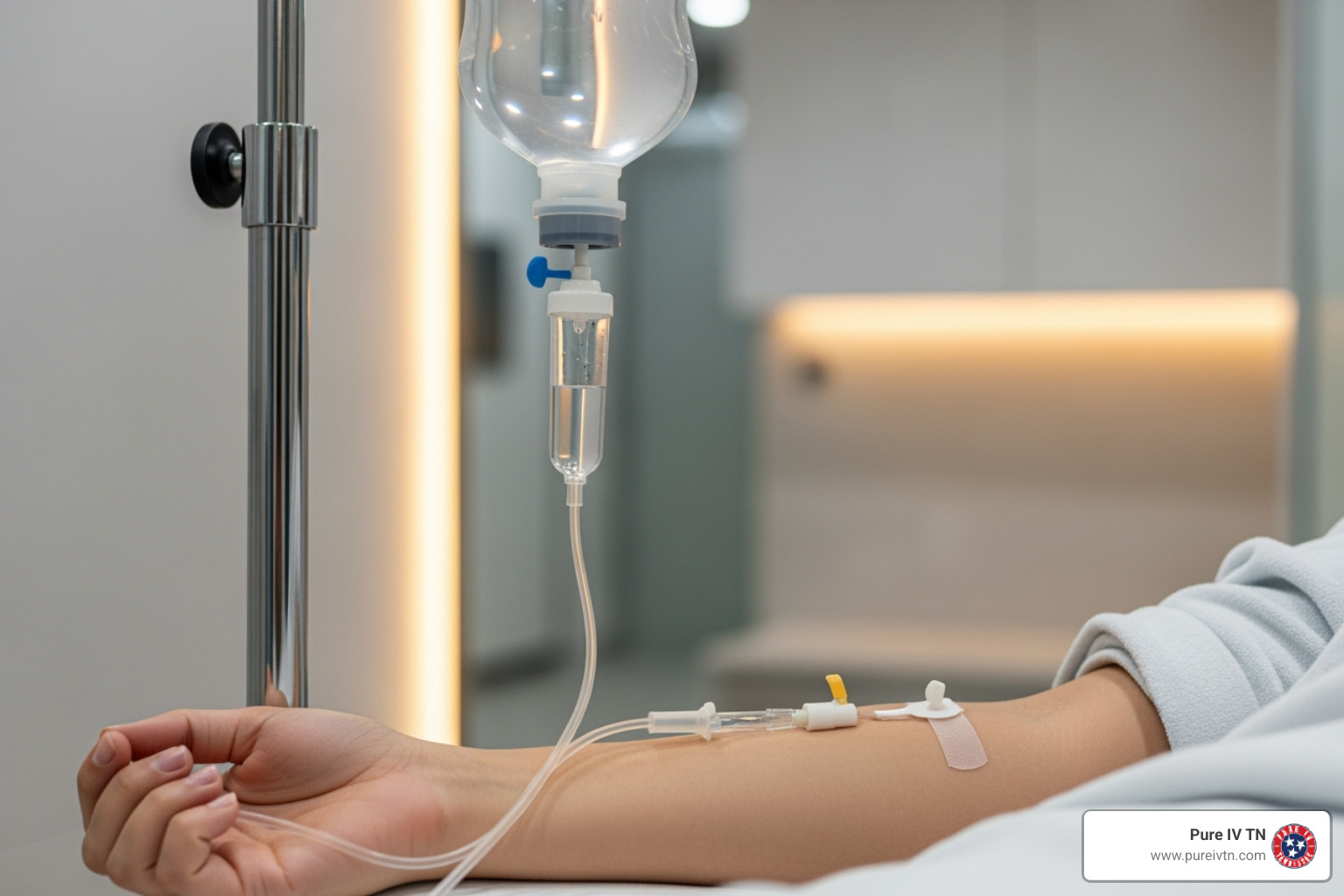IV Fluids for Lactic Acidosis: Treatment and Recovery
Lactic acidosis occurs when lactic acid accumulates in the blood more rapidly than the body can metabolize it. This results in a high anion gap metabolic acidosis, characterized by a blood pH below 7.35 and increased blood lactate levels above 4 mmol/L.
There are two main types of lactic acidosis:
- Type A lactic acidosis–Caused by tissue hypoxia, such as from shock, severe sepsis, or heart failure, which reduces tissue oxygen delivery and promotes anaerobic glycolysis. Anaerobic glycolysis is the process by which cells break down sugar for energy without using oxygen.
- Type B lactic acidosis–Occurring without hypoxia, triggered by metabolic disorders, toxins, or medications affecting lactate metabolism.
Symptoms of lactic acidosis range from nausea and vomiting to confusion, irregular cardiac rhythm, or organ dysfunction. Because lactic acidosis can be life-threatening, IV fluid resuscitation is often the first and most important step.
Why IV Fluids Are Essential in Treatment
IV fluids play a central role in managing lactic acidosis. They directly address the underlying physiological stress that causes lactate to accumulate. Without restoring fluid and electrolyte balance, other treatments often cannot succeed. Here are the benefits of IV fluids:
Restore Fluid Balance and Circulation
In lactic acidosis, dehydration and low blood pressure often reduce perfusion to tissues. Without enough circulating blood volume, oxygen delivery falls, forcing cells into anaerobic metabolism that generates even more lactate.
IV fluid administration expands plasma volume, restores perfusion, and improves tissue oxygen delivery. This is important in conditions like septic shock or heart failure.
Improve Oxygen Delivery and Reduce Anaerobic Metabolism
Oxygen is the body’s primary fuel for efficient energy production. When supply falls, cells switch to anaerobic metabolism, which produces lactic acid as a byproduct.
By improving circulation, IV fluids enhance oxygen delivery to cells and reduce reliance on this inefficient pathway. The result is a gradual slowing of lactic acid accumulation. In critical care, fluids are often paired with supplemental oxygen to maximize this benefit.
Dilute Acid and Lower Blood Lactate Concentration
Expanding blood volume lowers the concentration of arterial blood lactate, reducing acidity.
While this doesn’t “cure” the acidosis, it buys time for the body (and medical interventions) to metabolize and clear excess lactate safely.
Rebalance Electrolytes
Electrolyte imbalances are common in patients with lactic acidosis. Potassium, sodium, and chloride shifts trigger muscle weakness, irregular heartbeats, and nerve dysfunction. Some IV fluids—such as Lactated Ringer’s—contain a balanced electrolyte composition that restores stability.
Other intravenous fluids may be combined with potassium chloride to address deficiencies. Correcting electrolytes is critical not just for comfort, but for protecting heart rhythm and brain function.
Support Kidney Function and Lactate Clearance
The kidneys are vital in clearing acid from the blood and maintaining pH balance. Adequate fluid management supports the kidneys, liver, and heart. Hemodynamic monitoring (assesses a patient's blood flow, heart function, and tissue oxygenation) and serum electrolyte measurements guide safe dosing while avoiding fluid overload.
Create a Foundation for Other Treatments
Lactic acidosis is rarely treated with fluid therapy alone. Antibiotics (for sepsis), oxygen therapy, dialysis (in severe renal failure), or surgical interventions (to remove dead tissue or restore blood flow) may be necessary.
However, none of these treatments can be administered safely if blood pressure is dangerously low or circulation is unstable. Intravenous fluids stabilize the patient, creating a safe foundation for more targeted interventions.
Protect Against Organ Damage
By improving circulation and oxygenation, intravenous fluids help protect the brain, heart, and liver from hypoxic injury. Since lactic acidosis stresses multiple organ systems, stabilizing these with fluid therapy is essential for survival.
Types of IV Fluids Used in Lactic Acidosis
Different types of intravenous fluids may be chosen based on the patient’s condition, severity of acidosis, and underlying cause. Each fluid has specific advantages and potential limitations.
Normal Saline (0.9% Sodium Chloride)
Normal saline is often the first-line fluid in emergencies because it’s widely available, simple, and effective at rapidly restoring blood volume. It raises blood pressure, rehydrates tissues, and replaces lost sodium and chloride. For patients in shock or with severe dehydration, it is often the first choice.
However, because normal saline contains high chloride levels, very large infusions can lead to hyperchloremic metabolic acidosis. Hyperchloremic acidosis is a condition where excess chloride worsens acid-base balance. For this reason, providers carefully monitor vital signs, blood gases, and electrolytes during treatment, and may switch to a balanced salt solution if needed.
Lactated Ringer’s Solution
Lactated Ringer’s (LR) is considered a balanced crystalloid solution. In addition to sodium and chloride, it contains potassium and calcium, making it more similar to the body’s natural plasma composition. The lactate in Lactated Ringer solution acts as a buffer: once metabolized by the liver, it helps neutralize acid and stabilize blood pH.
Because of this, Ringer's lactate is often favored in fluid resuscitation, especially in trauma, burns, and surgical patients. However, in severe lactic acidosis, some providers hesitate to use it since it contains lactate. Lactate could theoretically add to the problem if the liver is unable to process it.
Clinical judgment is important—Ringer's lactate can be highly beneficial, but it must be tailored to the patient’s metabolic status.
Dextrose-Containing Fluids
In some cases of lactic acidosis, especially those linked to sepsis, hypoglycemia, or prolonged fasting, dextrose-containing fluids are used. By supplying glucose, these fluids give cells an immediate source of energy, reducing their reliance on anaerobic metabolism.
Dextrose solutions are often combined with normal saline or other electrolytes to support energy needs and hydration. They are important in patients with sepsis, liver disease, or alcohol-related lactic acidosis.
Sodium Bicarbonate (Special Cases)
Sodium bicarbonate therapy is a powerful alkalinizing agent reserved for life-threatening lactic acidosis. Typically, when blood pH drops below 7.0. By directly neutralizing acid in the bloodstream, sodium bicarbonate stabilizes the patient and reduces the immediate risk of heart rhythm disturbances or cardiac arrest.
However, its use is controversial because it can cause electrolyte shifts (like dangerously low potassium), reduced oxygen delivery to tissues, and paradoxical acidosis inside cells. For these reasons, sodium bicarbonate is usually administered only in intensive care settings. Continuous monitoring of blood pH levels, electrolytes, and oxygenation is done.
How IV Fluids Are Administered

Intravenous fluids are given through secure IV access at a monitored infusion site. Treatment involves:
- Careful fluid administration–Too little fluid won’t stabilize circulation, while too much may cause fluid overload.
- Monitoring blood gases–Providers track blood pH level, arterial blood lactate, and blood lactate levels.
- Checking electrolytes–Monitoring serum sodium, serum electrolytes, and comprehensive metabolic panel results.
- Adjusting treatment–Fluid therapy is adapted as the patient’s condition improves or if complications arise.
In severe cases, diuretic therapy may follow fluid replacement to prevent overload. Continuous fluid management ensures balance between resuscitation and safety.
IV Fluids Within a Broader Care Plan
While IV fluid replacement is important, it is rarely the only treatment. Lactic acidosis is often a complication of another condition, such as sepsis, heart failure, or respiratory distress. Addressing the root cause is essential.
Additional treatments may include:
- Oxygen therapy to improve tissue oxygenation.
- Antibiotics if sepsis is the trigger.
- Dialysis is used in severe cases, especially with kidney failure.
- Medications to support heart or lung function.
Recovery and Monitoring
Stabilization with intravenous fluids is only the first step in managing metabolic acidosis. Because the condition can quickly worsen or recur if the underlying issue isn’t addressed, close monitoring is important.
Patients are usually observed through:
- Regular blood tests–Lactate levels are checked to confirm that acidosis is improving. Blood gases and pH provide insight into oxygenation and acid-base balance, while electrolyte panels monitor sodium, potassium, and chloride levels.
- Organ function tests–Kidney and liver function are assessed since these organs play critical roles in clearing lactic acid and processing IV fluids. Heart monitoring may also be done, as acidosis can strain cardiac function.
- Vital signs–Blood pressure, heart rate, respiratory rate, and oxygen saturation are continuously monitored to ensure tissues are receiving enough oxygen.
Transition to Oral Hydration and Nutrition
As the patient’s condition stabilizes, IV fluids are gradually reduced and replaced with oral hydration to maintain balance. At this stage, restoring adequate nutrition is important. Patients may receive dietary guidance that includes:
- Sufficient carbohydrates and proteins to support energy metabolism.
- Foods rich in B vitamins and antioxidants help cells use oxygen more effectively.
- Tailored dietary adjustments depending on whether the lactic acidosis was linked to liver disease, diabetes, alcohol use, or another condition.
Preventing Recurrence
Recovery also focuses on addressing the root cause. For example:
- Patients with sepsis may continue on antibiotics and oxygen therapy.
- Those with chronic conditions like kidney failure or liver disease may require long-term treatment plans.
- Athletes or individuals with exertional lactic acidosis may need counseling on hydration strategies and pacing during intense exercise.
Lifestyle support is emphasized as well. Adequate hydration, proper nutrition, and ongoing medical supervision help prevent future episodes.
For ongoing support, patients may also consider working with trusted IV providers. For example, Pure IV Tennessee specializes in professional, medically supervised IV hydration services that go beyond simple fluid replacement. We offer:
- Licensed medical staff to ensure safety with every infusion.
- Customized treatment plans tailored to individual needs, whether for recovery, hydration, or wellness support.
- Convenient scheduling and care designed to fit into patients’ busy lives.
- Bring IV care directly to your doorstep, combining clinical expertise with the convenience of at-home wellness.
By choosing us, you get safe, effective, and personalized care to support both short-term recovery and long-term health.













